Construction Technology 5 - Envelope Assignment 3: Sound
VerifiedAdded on 2022/11/13
|8
|1086
|43
Homework Assignment
AI Summary
This assignment, completed by a student, addresses sound reduction in construction, covering various aspects of noise control and acoustic design. The student explores three methods to reduce noise at its source, utilizing diagrams to illustrate soundproofing enclosures, high acoustic impedance areas, and source isolation. The assignment also details flanking sound transmission pathways, mitigation strategies such as caulking and staggering fixtures, and the challenges of structure-borne sound in older apartment blocks. Discontinuous construction techniques for sound reduction are explained with diagrams. Finally, the principles of auditorium design for live theatre are presented, emphasizing the use of direct and indirect sound to achieve optimal acoustics, including the roles of reflectors and absorbent surfaces. This comprehensive analysis offers practical insights into building acoustics and noise management.

Page 0 of 9
Construction Technology 5 – Envelope Assignment 3 – Sound
Autumn 2018
Kameran Al-Razak - 18528637
Construction Technology 5 – Envelope Assignment 3 – Sound
Autumn 2018
Kameran Al-Razak - 18528637
Paraphrase This Document
Need a fresh take? Get an instant paraphrase of this document with our AI Paraphraser

Table of Contents
Question 1...................................................................................................................................................2
Question 2...................................................................................................................................................4
Question 3...................................................................................................................................................5
Question 4...................................................................................................................................................6
Question 5...................................................................................................................................................7
Page 1 of 9
18528637 – Kameran Al-Razak
Question 1...................................................................................................................................................2
Question 2...................................................................................................................................................4
Question 3...................................................................................................................................................5
Question 4...................................................................................................................................................6
Question 5...................................................................................................................................................7
Page 1 of 9
18528637 – Kameran Al-Razak
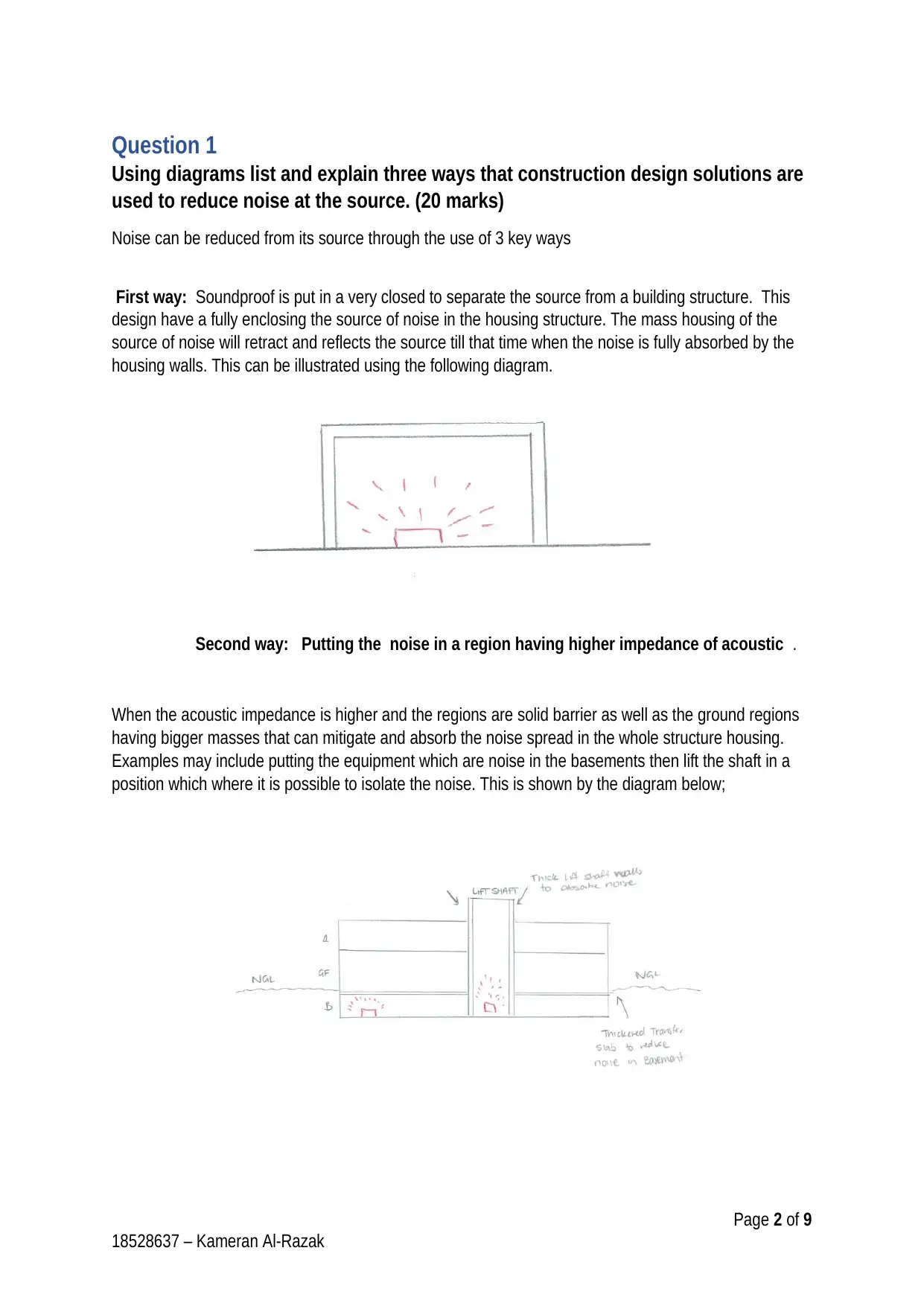
Question 1
Using diagrams list and explain three ways that construction design solutions are
used to reduce noise at the source. (20 marks)
Noise can be reduced from its source through the use of 3 key ways
First way: Soundproof is put in a very closed to separate the source from a building structure. This
design have a fully enclosing the source of noise in the housing structure. The mass housing of the
source of noise will retract and reflects the source till that time when the noise is fully absorbed by the
housing walls. This can be illustrated using the following diagram.
Second way: Putting the noise in a region having higher impedance of acoustic .
When the acoustic impedance is higher and the regions are solid barrier as well as the ground regions
having bigger masses that can mitigate and absorb the noise spread in the whole structure housing.
Examples may include putting the equipment which are noise in the basements then lift the shaft in a
position which where it is possible to isolate the noise. This is shown by the diagram below;
Page 2 of 9
18528637 – Kameran Al-Razak
Using diagrams list and explain three ways that construction design solutions are
used to reduce noise at the source. (20 marks)
Noise can be reduced from its source through the use of 3 key ways
First way: Soundproof is put in a very closed to separate the source from a building structure. This
design have a fully enclosing the source of noise in the housing structure. The mass housing of the
source of noise will retract and reflects the source till that time when the noise is fully absorbed by the
housing walls. This can be illustrated using the following diagram.
Second way: Putting the noise in a region having higher impedance of acoustic .
When the acoustic impedance is higher and the regions are solid barrier as well as the ground regions
having bigger masses that can mitigate and absorb the noise spread in the whole structure housing.
Examples may include putting the equipment which are noise in the basements then lift the shaft in a
position which where it is possible to isolate the noise. This is shown by the diagram below;
Page 2 of 9
18528637 – Kameran Al-Razak
⊘ This is a preview!⊘
Do you want full access?
Subscribe today to unlock all pages.

Trusted by 1+ million students worldwide
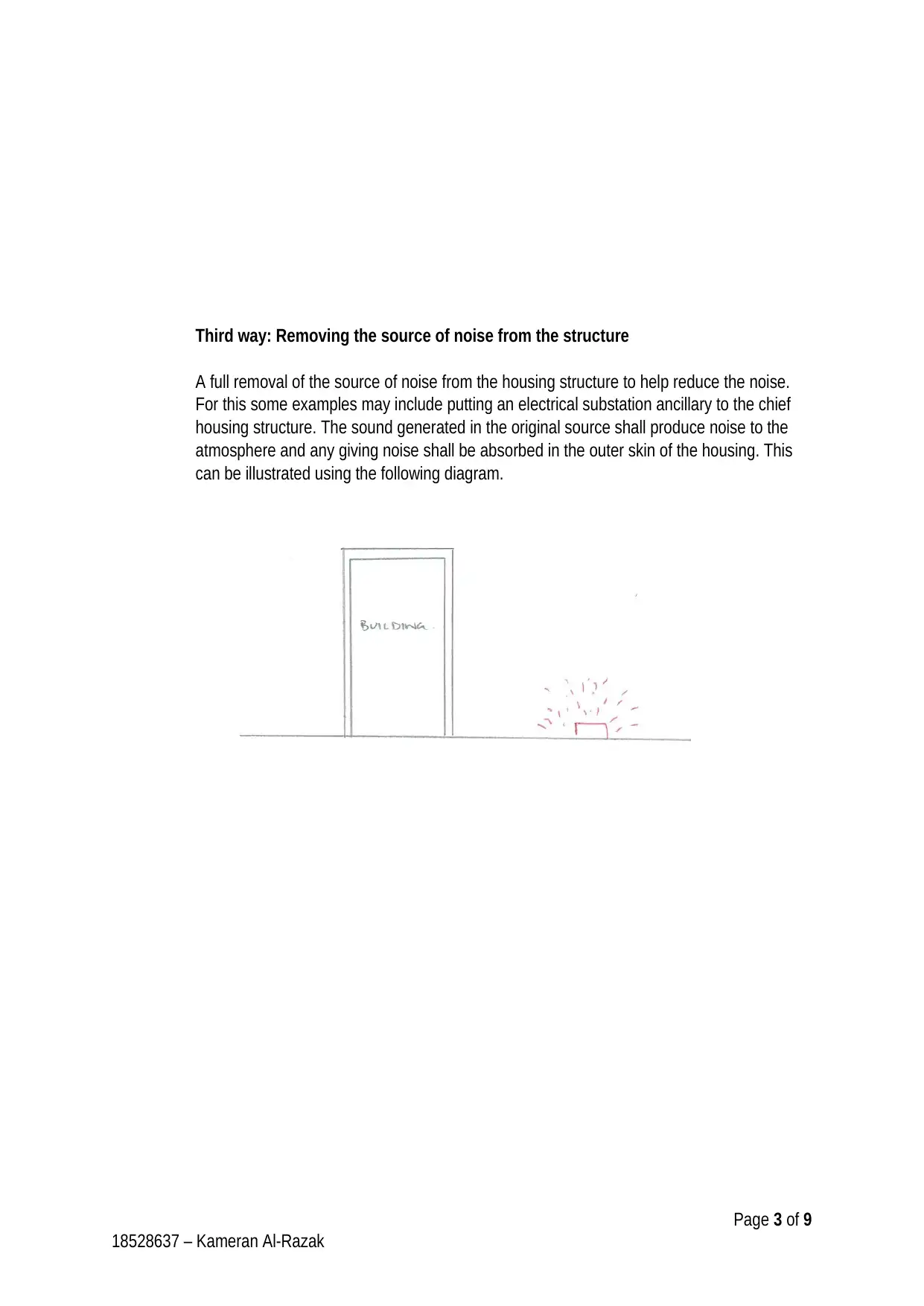
Third way: Removing the source of noise from the structure
A full removal of the source of noise from the housing structure to help reduce the noise.
For this some examples may include putting an electrical substation ancillary to the chief
housing structure. The sound generated in the original source shall produce noise to the
atmosphere and any giving noise shall be absorbed in the outer skin of the housing. This
can be illustrated using the following diagram.
Page 3 of 9
18528637 – Kameran Al-Razak
A full removal of the source of noise from the housing structure to help reduce the noise.
For this some examples may include putting an electrical substation ancillary to the chief
housing structure. The sound generated in the original source shall produce noise to the
atmosphere and any giving noise shall be absorbed in the outer skin of the housing. This
can be illustrated using the following diagram.
Page 3 of 9
18528637 – Kameran Al-Razak
Paraphrase This Document
Need a fresh take? Get an instant paraphrase of this document with our AI Paraphraser
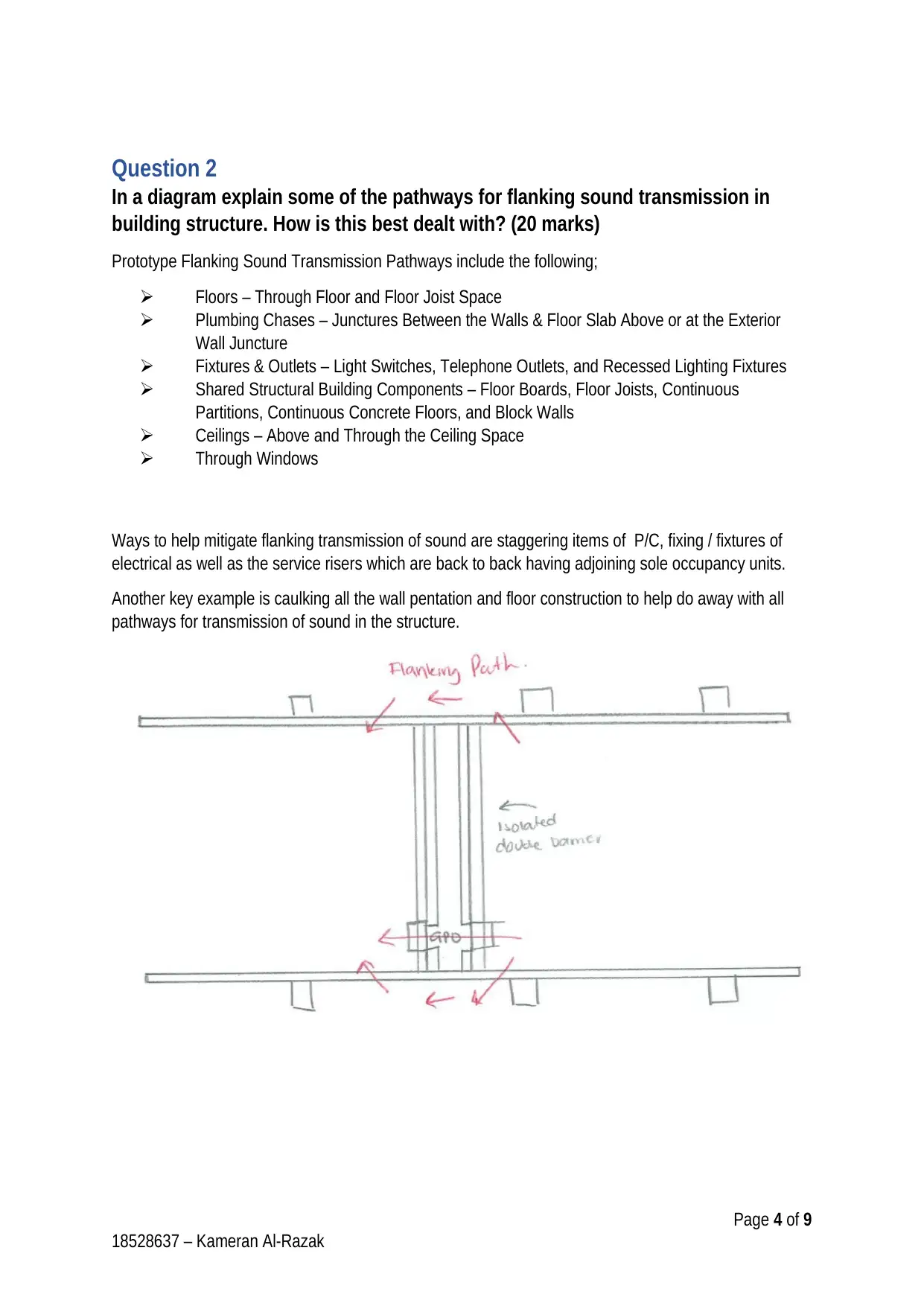
Question 2
In a diagram explain some of the pathways for flanking sound transmission in
building structure. How is this best dealt with? (20 marks)
Prototype Flanking Sound Transmission Pathways include the following;
Floors – Through Floor and Floor Joist Space
Plumbing Chases – Junctures Between the Walls & Floor Slab Above or at the Exterior
Wall Juncture
Fixtures & Outlets – Light Switches, Telephone Outlets, and Recessed Lighting Fixtures
Shared Structural Building Components – Floor Boards, Floor Joists, Continuous
Partitions, Continuous Concrete Floors, and Block Walls
Ceilings – Above and Through the Ceiling Space
Through Windows
Ways to help mitigate flanking transmission of sound are staggering items of P/C, fixing / fixtures of
electrical as well as the service risers which are back to back having adjoining sole occupancy units.
Another key example is caulking all the wall pentation and floor construction to help do away with all
pathways for transmission of sound in the structure.
Page 4 of 9
18528637 – Kameran Al-Razak
In a diagram explain some of the pathways for flanking sound transmission in
building structure. How is this best dealt with? (20 marks)
Prototype Flanking Sound Transmission Pathways include the following;
Floors – Through Floor and Floor Joist Space
Plumbing Chases – Junctures Between the Walls & Floor Slab Above or at the Exterior
Wall Juncture
Fixtures & Outlets – Light Switches, Telephone Outlets, and Recessed Lighting Fixtures
Shared Structural Building Components – Floor Boards, Floor Joists, Continuous
Partitions, Continuous Concrete Floors, and Block Walls
Ceilings – Above and Through the Ceiling Space
Through Windows
Ways to help mitigate flanking transmission of sound are staggering items of P/C, fixing / fixtures of
electrical as well as the service risers which are back to back having adjoining sole occupancy units.
Another key example is caulking all the wall pentation and floor construction to help do away with all
pathways for transmission of sound in the structure.
Page 4 of 9
18528637 – Kameran Al-Razak

Question 3
Why is structure-borne sound transmission often a problem in older residential
apartment blocks? Give an example. (20 marks)
Transmission of sound in older block apartment is a key problem since there is a different standards for
the construction for given times of construction till now. Majority development in mitigating transmission
of sound as well as standard of acoustic which are currently discovered hence older building styles will
not be in accordance with the new standards.
Current development for the BCA which are in BCA volume 1 and section J set out the current
standards in ways of construction to reduce the transmission sound in the housing.
Sound transmission examples in older block apartment can be viewed in steel framed structure as good
technology for insulation of acoustic where not employed. It is possible for the sound to resonate in the
steel subframe of the housing structure hence transmit between several sole occupancy unit in the
housing structure. Currently in construction there are ways to mitigate this transmission of sound would
constitute composite slab flooring as well as the acoustic underlay to help reflect the sound back for it
to be absorbed.
For the old structure renovation to comply with the current day acoustic standards is a long process and
it is also costly at the same time that owner don’t want to pay for.
Page 5 of 9
18528637 – Kameran Al-Razak
Why is structure-borne sound transmission often a problem in older residential
apartment blocks? Give an example. (20 marks)
Transmission of sound in older block apartment is a key problem since there is a different standards for
the construction for given times of construction till now. Majority development in mitigating transmission
of sound as well as standard of acoustic which are currently discovered hence older building styles will
not be in accordance with the new standards.
Current development for the BCA which are in BCA volume 1 and section J set out the current
standards in ways of construction to reduce the transmission sound in the housing.
Sound transmission examples in older block apartment can be viewed in steel framed structure as good
technology for insulation of acoustic where not employed. It is possible for the sound to resonate in the
steel subframe of the housing structure hence transmit between several sole occupancy unit in the
housing structure. Currently in construction there are ways to mitigate this transmission of sound would
constitute composite slab flooring as well as the acoustic underlay to help reflect the sound back for it
to be absorbed.
For the old structure renovation to comply with the current day acoustic standards is a long process and
it is also costly at the same time that owner don’t want to pay for.
Page 5 of 9
18528637 – Kameran Al-Razak
⊘ This is a preview!⊘
Do you want full access?
Subscribe today to unlock all pages.

Trusted by 1+ million students worldwide
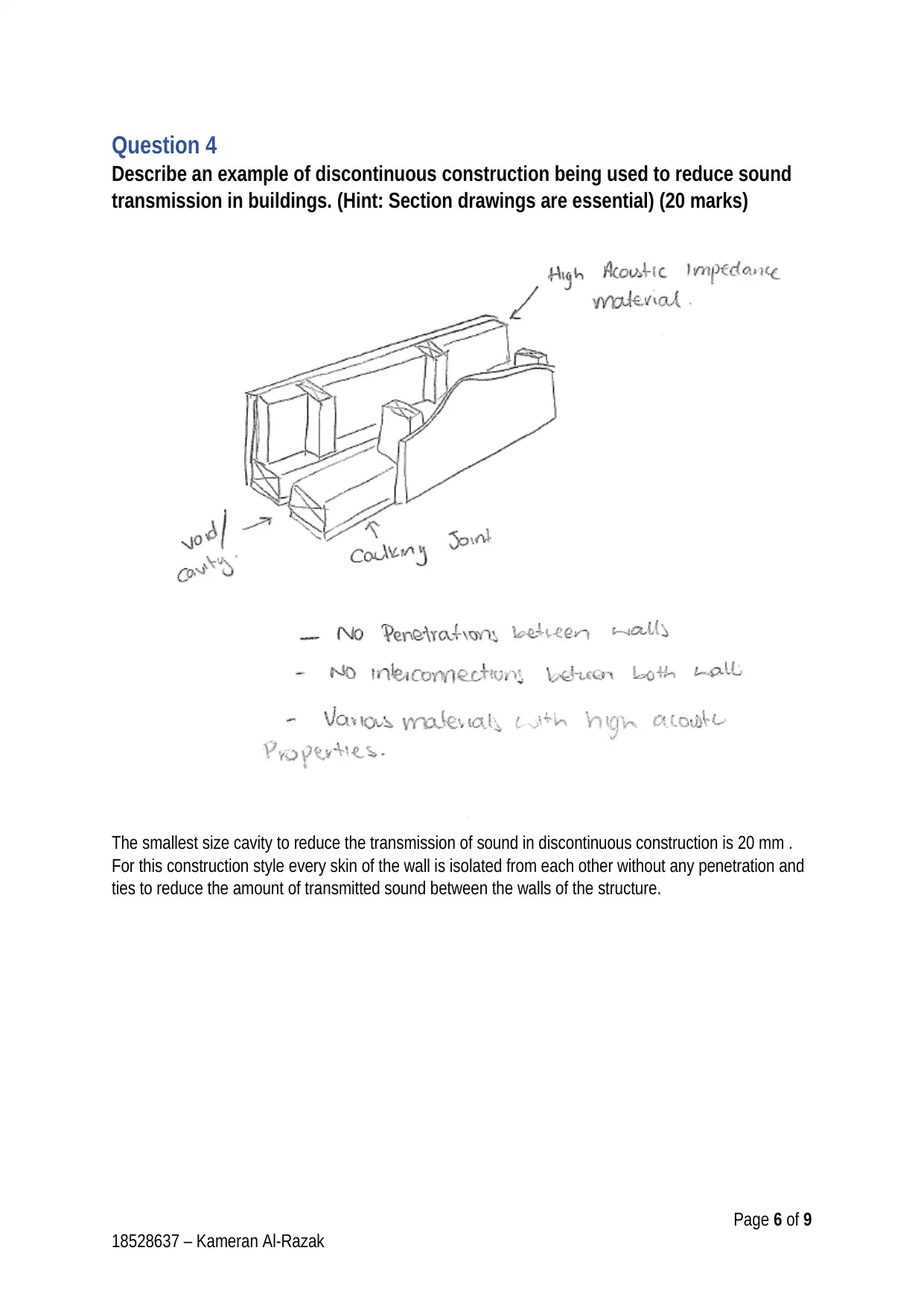
Question 4
Describe an example of discontinuous construction being used to reduce sound
transmission in buildings. (Hint: Section drawings are essential) (20 marks)
The smallest size cavity to reduce the transmission of sound in discontinuous construction is 20 mm .
For this construction style every skin of the wall is isolated from each other without any penetration and
ties to reduce the amount of transmitted sound between the walls of the structure.
Page 6 of 9
18528637 – Kameran Al-Razak
Describe an example of discontinuous construction being used to reduce sound
transmission in buildings. (Hint: Section drawings are essential) (20 marks)
The smallest size cavity to reduce the transmission of sound in discontinuous construction is 20 mm .
For this construction style every skin of the wall is isolated from each other without any penetration and
ties to reduce the amount of transmitted sound between the walls of the structure.
Page 6 of 9
18528637 – Kameran Al-Razak
Paraphrase This Document
Need a fresh take? Get an instant paraphrase of this document with our AI Paraphraser
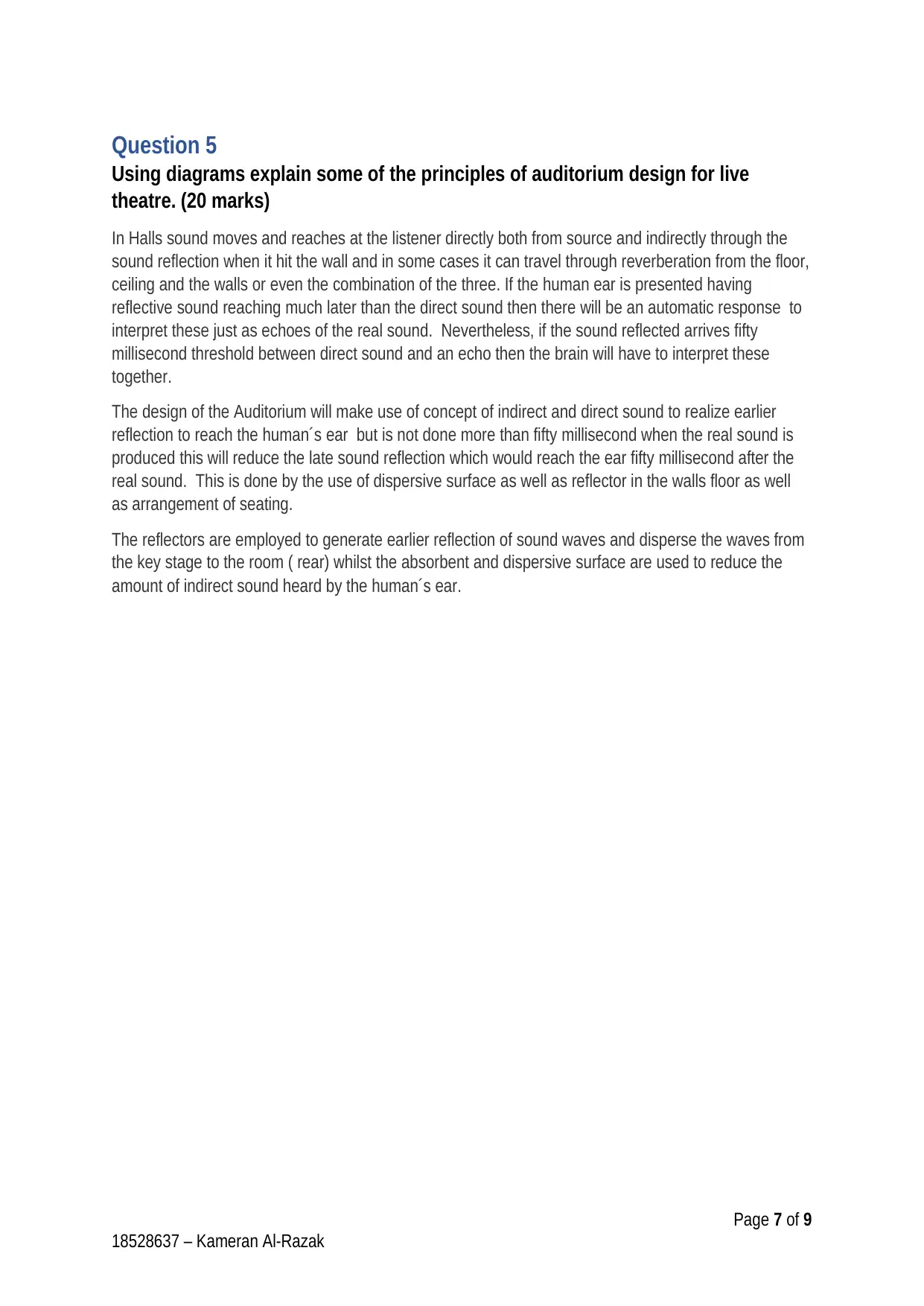
Question 5
Using diagrams explain some of the principles of auditorium design for live
theatre. (20 marks)
In Halls sound moves and reaches at the listener directly both from source and indirectly through the
sound reflection when it hit the wall and in some cases it can travel through reverberation from the floor,
ceiling and the walls or even the combination of the three. If the human ear is presented having
reflective sound reaching much later than the direct sound then there will be an automatic response to
interpret these just as echoes of the real sound. Nevertheless, if the sound reflected arrives fifty
millisecond threshold between direct sound and an echo then the brain will have to interpret these
together.
The design of the Auditorium will make use of concept of indirect and direct sound to realize earlier
reflection to reach the human´s ear but is not done more than fifty millisecond when the real sound is
produced this will reduce the late sound reflection which would reach the ear fifty millisecond after the
real sound. This is done by the use of dispersive surface as well as reflector in the walls floor as well
as arrangement of seating.
The reflectors are employed to generate earlier reflection of sound waves and disperse the waves from
the key stage to the room ( rear) whilst the absorbent and dispersive surface are used to reduce the
amount of indirect sound heard by the human´s ear.
Page 7 of 9
18528637 – Kameran Al-Razak
Using diagrams explain some of the principles of auditorium design for live
theatre. (20 marks)
In Halls sound moves and reaches at the listener directly both from source and indirectly through the
sound reflection when it hit the wall and in some cases it can travel through reverberation from the floor,
ceiling and the walls or even the combination of the three. If the human ear is presented having
reflective sound reaching much later than the direct sound then there will be an automatic response to
interpret these just as echoes of the real sound. Nevertheless, if the sound reflected arrives fifty
millisecond threshold between direct sound and an echo then the brain will have to interpret these
together.
The design of the Auditorium will make use of concept of indirect and direct sound to realize earlier
reflection to reach the human´s ear but is not done more than fifty millisecond when the real sound is
produced this will reduce the late sound reflection which would reach the ear fifty millisecond after the
real sound. This is done by the use of dispersive surface as well as reflector in the walls floor as well
as arrangement of seating.
The reflectors are employed to generate earlier reflection of sound waves and disperse the waves from
the key stage to the room ( rear) whilst the absorbent and dispersive surface are used to reduce the
amount of indirect sound heard by the human´s ear.
Page 7 of 9
18528637 – Kameran Al-Razak
1 out of 8
Related Documents
Your All-in-One AI-Powered Toolkit for Academic Success.
+13062052269
info@desklib.com
Available 24*7 on WhatsApp / Email
![[object Object]](/_next/static/media/star-bottom.7253800d.svg)
Unlock your academic potential
Copyright © 2020–2025 A2Z Services. All Rights Reserved. Developed and managed by ZUCOL.



